Impact of School Vending Machines on Student Health and Well-being
VerifiedAdded on 2020/07/23
|7
|1840
|65
Essay
AI Summary
This essay investigates the detrimental effects of school vending machines on student health, arguing that the sale of fizzy drinks, sweets, and unhealthy snacks should be prohibited. It highlights how these machines contribute to poor eating habits, obesity, and diabetes, particularly among children. The essay presents arguments supported by research, emphasizing the negative impact of high-sugar, low-nutrient foods on students' physical and mental development. It discusses the role of vending machines in schools, their financial benefits, and the importance of offering healthier alternatives. The essay also addresses the potential for increased costs and reduced consumption of healthy items while advocating for strategies to promote healthier food choices, such as including them in meal coupons and trays. The conclusion emphasizes the need for school authorities to prioritize student health by carefully analyzing the negative impacts of unhealthy food items and promoting better nutritional choices to ensure a healthier future for students. It also considers the malfunctioning of vending machines.

Academic research and
writing
writing
Paraphrase This Document
Need a fresh take? Get an instant paraphrase of this document with our AI Paraphraser
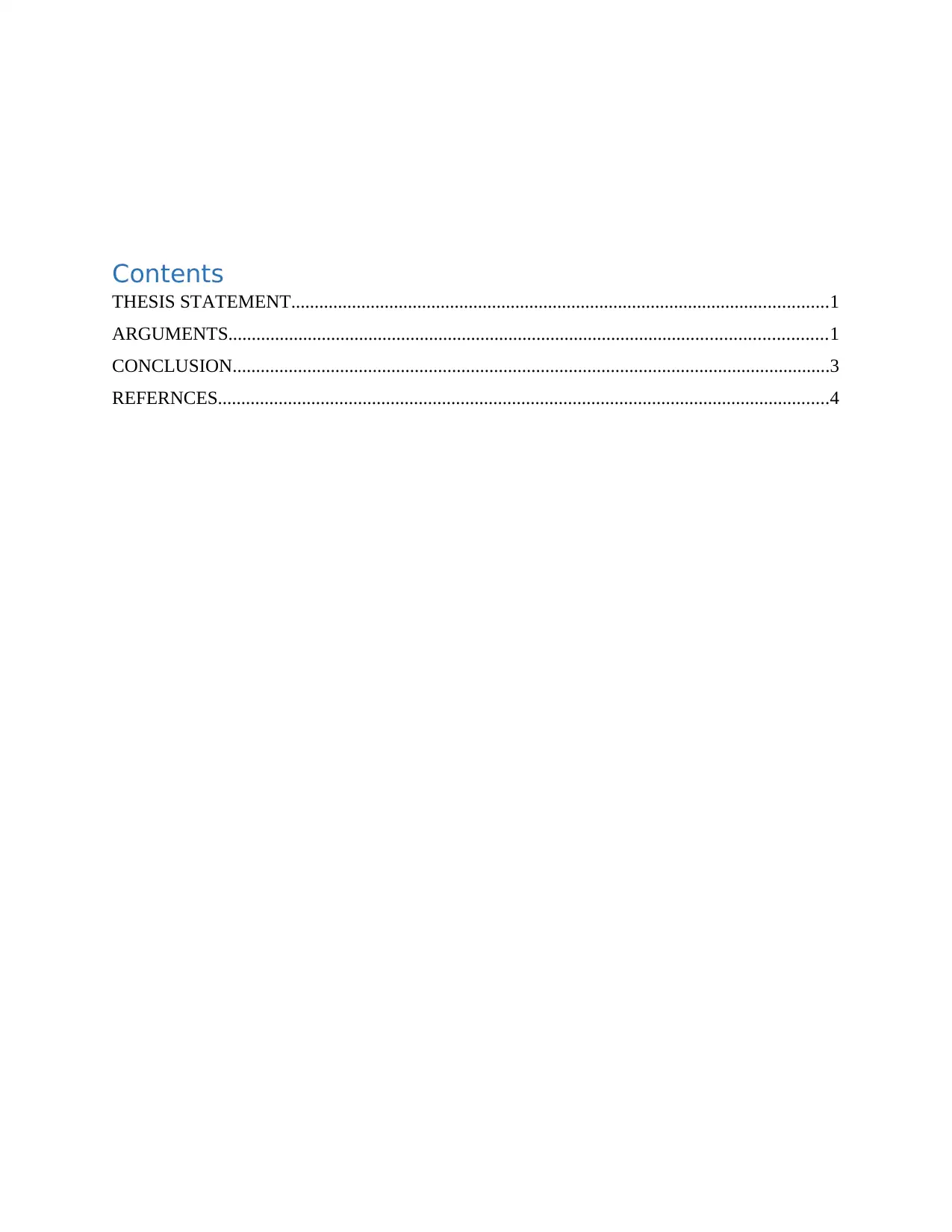
Contents
THESIS STATEMENT...................................................................................................................1
ARGUMENTS................................................................................................................................1
CONCLUSION................................................................................................................................3
REFERNCES...................................................................................................................................4
THESIS STATEMENT...................................................................................................................1
ARGUMENTS................................................................................................................................1
CONCLUSION................................................................................................................................3
REFERNCES...................................................................................................................................4
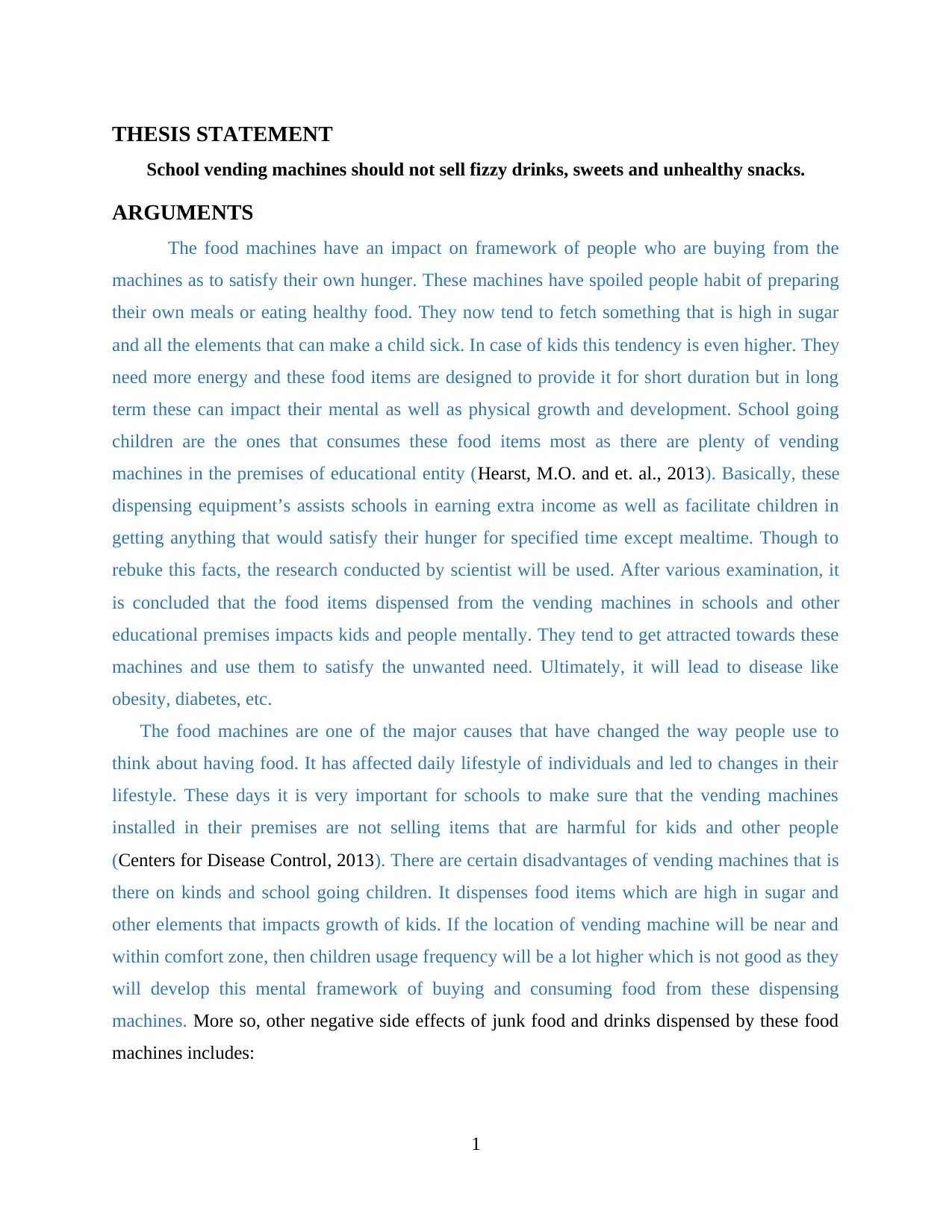
THESIS STATEMENT
School vending machines should not sell fizzy drinks, sweets and unhealthy snacks.
ARGUMENTS
The food machines have an impact on framework of people who are buying from the
machines as to satisfy their own hunger. These machines have spoiled people habit of preparing
their own meals or eating healthy food. They now tend to fetch something that is high in sugar
and all the elements that can make a child sick. In case of kids this tendency is even higher. They
need more energy and these food items are designed to provide it for short duration but in long
term these can impact their mental as well as physical growth and development. School going
children are the ones that consumes these food items most as there are plenty of vending
machines in the premises of educational entity (Hearst, M.O. and et. al., 2013). Basically, these
dispensing equipment’s assists schools in earning extra income as well as facilitate children in
getting anything that would satisfy their hunger for specified time except mealtime. Though to
rebuke this facts, the research conducted by scientist will be used. After various examination, it
is concluded that the food items dispensed from the vending machines in schools and other
educational premises impacts kids and people mentally. They tend to get attracted towards these
machines and use them to satisfy the unwanted need. Ultimately, it will lead to disease like
obesity, diabetes, etc.
The food machines are one of the major causes that have changed the way people use to
think about having food. It has affected daily lifestyle of individuals and led to changes in their
lifestyle. These days it is very important for schools to make sure that the vending machines
installed in their premises are not selling items that are harmful for kids and other people
(Centers for Disease Control, 2013). There are certain disadvantages of vending machines that is
there on kinds and school going children. It dispenses food items which are high in sugar and
other elements that impacts growth of kids. If the location of vending machine will be near and
within comfort zone, then children usage frequency will be a lot higher which is not good as they
will develop this mental framework of buying and consuming food from these dispensing
machines. More so, other negative side effects of junk food and drinks dispensed by these food
machines includes:
1
School vending machines should not sell fizzy drinks, sweets and unhealthy snacks.
ARGUMENTS
The food machines have an impact on framework of people who are buying from the
machines as to satisfy their own hunger. These machines have spoiled people habit of preparing
their own meals or eating healthy food. They now tend to fetch something that is high in sugar
and all the elements that can make a child sick. In case of kids this tendency is even higher. They
need more energy and these food items are designed to provide it for short duration but in long
term these can impact their mental as well as physical growth and development. School going
children are the ones that consumes these food items most as there are plenty of vending
machines in the premises of educational entity (Hearst, M.O. and et. al., 2013). Basically, these
dispensing equipment’s assists schools in earning extra income as well as facilitate children in
getting anything that would satisfy their hunger for specified time except mealtime. Though to
rebuke this facts, the research conducted by scientist will be used. After various examination, it
is concluded that the food items dispensed from the vending machines in schools and other
educational premises impacts kids and people mentally. They tend to get attracted towards these
machines and use them to satisfy the unwanted need. Ultimately, it will lead to disease like
obesity, diabetes, etc.
The food machines are one of the major causes that have changed the way people use to
think about having food. It has affected daily lifestyle of individuals and led to changes in their
lifestyle. These days it is very important for schools to make sure that the vending machines
installed in their premises are not selling items that are harmful for kids and other people
(Centers for Disease Control, 2013). There are certain disadvantages of vending machines that is
there on kinds and school going children. It dispenses food items which are high in sugar and
other elements that impacts growth of kids. If the location of vending machine will be near and
within comfort zone, then children usage frequency will be a lot higher which is not good as they
will develop this mental framework of buying and consuming food from these dispensing
machines. More so, other negative side effects of junk food and drinks dispensed by these food
machines includes:
1
⊘ This is a preview!⊘
Do you want full access?
Subscribe today to unlock all pages.

Trusted by 1+ million students worldwide
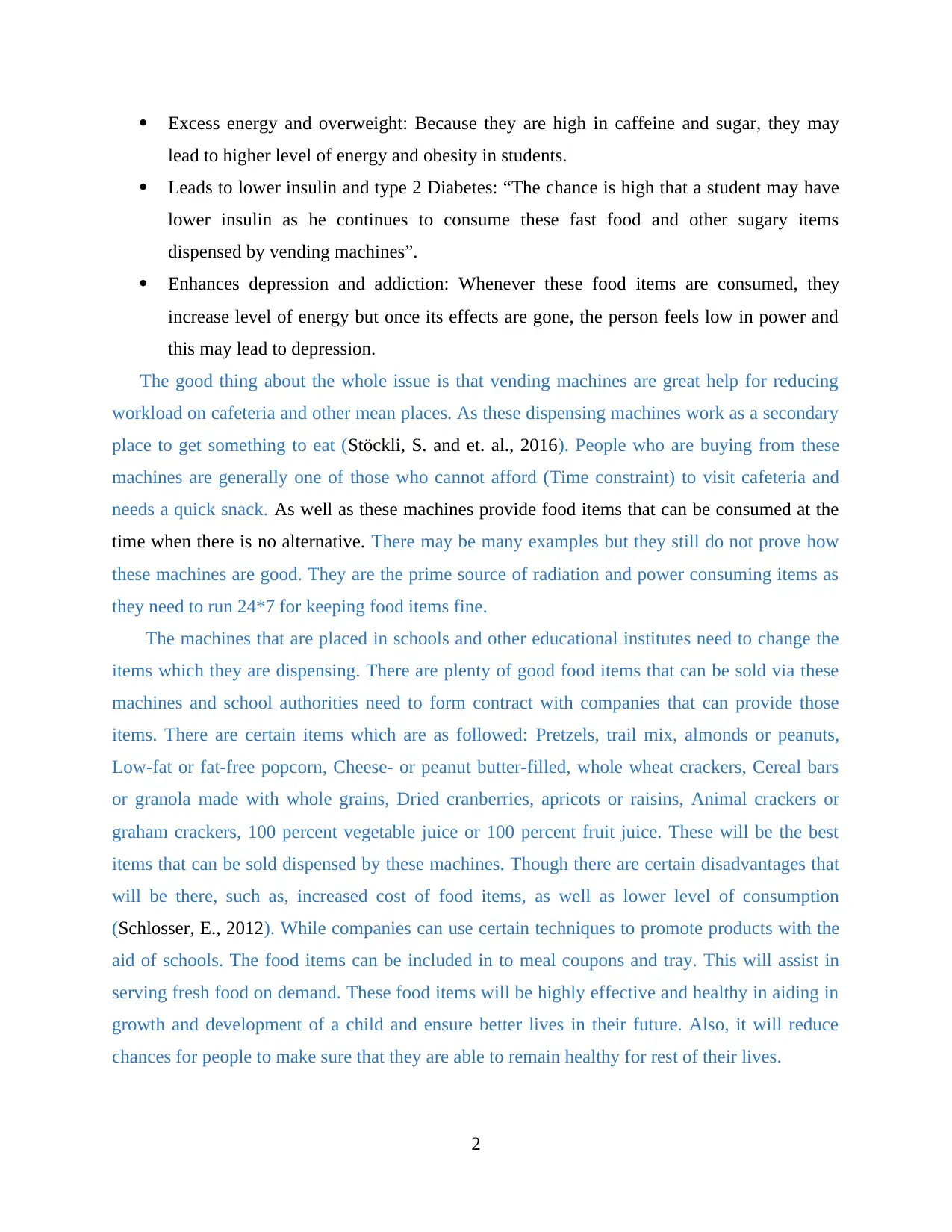
Excess energy and overweight: Because they are high in caffeine and sugar, they may
lead to higher level of energy and obesity in students.
Leads to lower insulin and type 2 Diabetes: “The chance is high that a student may have
lower insulin as he continues to consume these fast food and other sugary items
dispensed by vending machines”.
Enhances depression and addiction: Whenever these food items are consumed, they
increase level of energy but once its effects are gone, the person feels low in power and
this may lead to depression.
The good thing about the whole issue is that vending machines are great help for reducing
workload on cafeteria and other mean places. As these dispensing machines work as a secondary
place to get something to eat (Stöckli, S. and et. al., 2016). People who are buying from these
machines are generally one of those who cannot afford (Time constraint) to visit cafeteria and
needs a quick snack. As well as these machines provide food items that can be consumed at the
time when there is no alternative. There may be many examples but they still do not prove how
these machines are good. They are the prime source of radiation and power consuming items as
they need to run 24*7 for keeping food items fine.
The machines that are placed in schools and other educational institutes need to change the
items which they are dispensing. There are plenty of good food items that can be sold via these
machines and school authorities need to form contract with companies that can provide those
items. There are certain items which are as followed: Pretzels, trail mix, almonds or peanuts,
Low-fat or fat-free popcorn, Cheese- or peanut butter-filled, whole wheat crackers, Cereal bars
or granola made with whole grains, Dried cranberries, apricots or raisins, Animal crackers or
graham crackers, 100 percent vegetable juice or 100 percent fruit juice. These will be the best
items that can be sold dispensed by these machines. Though there are certain disadvantages that
will be there, such as, increased cost of food items, as well as lower level of consumption
(Schlosser, E., 2012). While companies can use certain techniques to promote products with the
aid of schools. The food items can be included in to meal coupons and tray. This will assist in
serving fresh food on demand. These food items will be highly effective and healthy in aiding in
growth and development of a child and ensure better lives in their future. Also, it will reduce
chances for people to make sure that they are able to remain healthy for rest of their lives.
2
lead to higher level of energy and obesity in students.
Leads to lower insulin and type 2 Diabetes: “The chance is high that a student may have
lower insulin as he continues to consume these fast food and other sugary items
dispensed by vending machines”.
Enhances depression and addiction: Whenever these food items are consumed, they
increase level of energy but once its effects are gone, the person feels low in power and
this may lead to depression.
The good thing about the whole issue is that vending machines are great help for reducing
workload on cafeteria and other mean places. As these dispensing machines work as a secondary
place to get something to eat (Stöckli, S. and et. al., 2016). People who are buying from these
machines are generally one of those who cannot afford (Time constraint) to visit cafeteria and
needs a quick snack. As well as these machines provide food items that can be consumed at the
time when there is no alternative. There may be many examples but they still do not prove how
these machines are good. They are the prime source of radiation and power consuming items as
they need to run 24*7 for keeping food items fine.
The machines that are placed in schools and other educational institutes need to change the
items which they are dispensing. There are plenty of good food items that can be sold via these
machines and school authorities need to form contract with companies that can provide those
items. There are certain items which are as followed: Pretzels, trail mix, almonds or peanuts,
Low-fat or fat-free popcorn, Cheese- or peanut butter-filled, whole wheat crackers, Cereal bars
or granola made with whole grains, Dried cranberries, apricots or raisins, Animal crackers or
graham crackers, 100 percent vegetable juice or 100 percent fruit juice. These will be the best
items that can be sold dispensed by these machines. Though there are certain disadvantages that
will be there, such as, increased cost of food items, as well as lower level of consumption
(Schlosser, E., 2012). While companies can use certain techniques to promote products with the
aid of schools. The food items can be included in to meal coupons and tray. This will assist in
serving fresh food on demand. These food items will be highly effective and healthy in aiding in
growth and development of a child and ensure better lives in their future. Also, it will reduce
chances for people to make sure that they are able to remain healthy for rest of their lives.
2
Paraphrase This Document
Need a fresh take? Get an instant paraphrase of this document with our AI Paraphraser
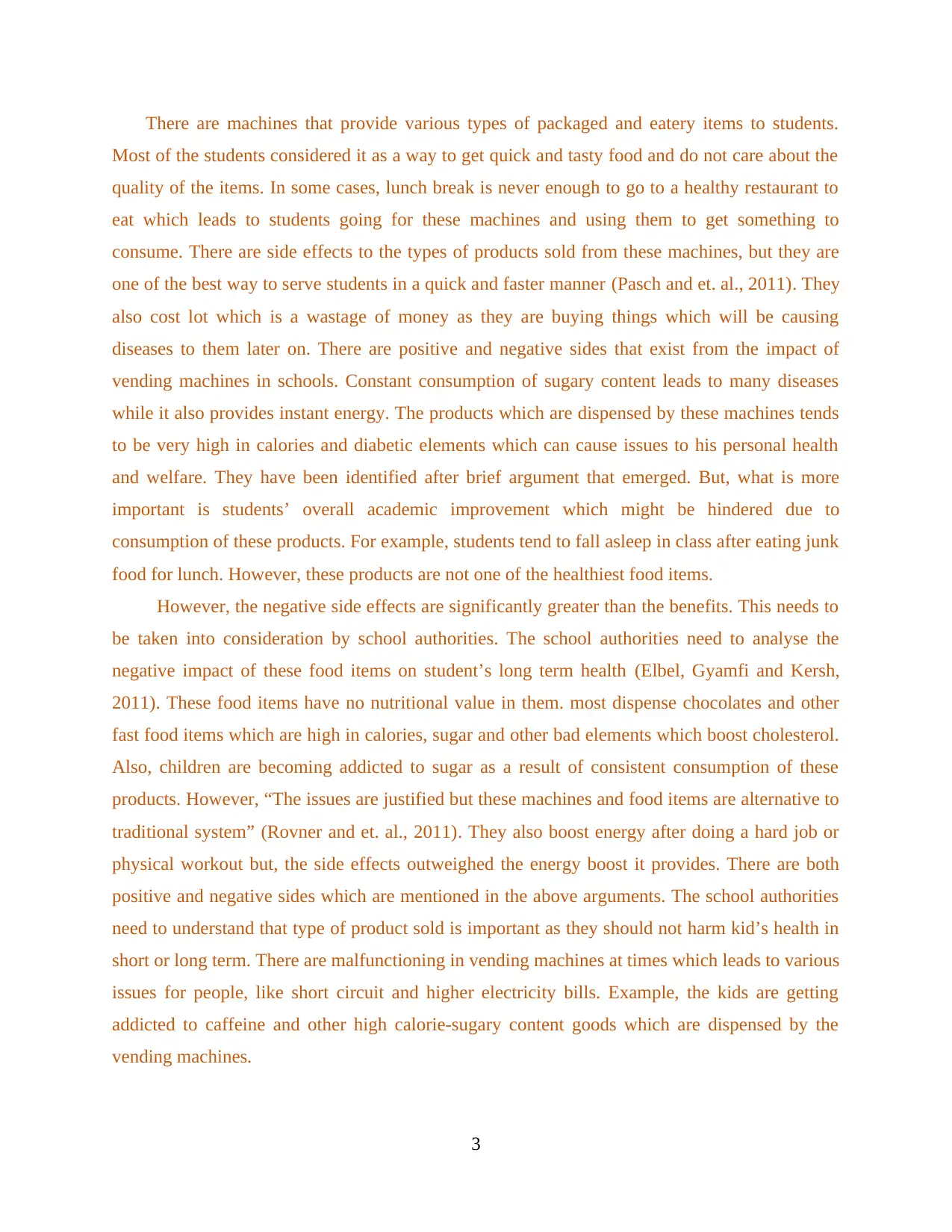
There are machines that provide various types of packaged and eatery items to students.
Most of the students considered it as a way to get quick and tasty food and do not care about the
quality of the items. In some cases, lunch break is never enough to go to a healthy restaurant to
eat which leads to students going for these machines and using them to get something to
consume. There are side effects to the types of products sold from these machines, but they are
one of the best way to serve students in a quick and faster manner (Pasch and et. al., 2011). They
also cost lot which is a wastage of money as they are buying things which will be causing
diseases to them later on. There are positive and negative sides that exist from the impact of
vending machines in schools. Constant consumption of sugary content leads to many diseases
while it also provides instant energy. The products which are dispensed by these machines tends
to be very high in calories and diabetic elements which can cause issues to his personal health
and welfare. They have been identified after brief argument that emerged. But, what is more
important is students’ overall academic improvement which might be hindered due to
consumption of these products. For example, students tend to fall asleep in class after eating junk
food for lunch. However, these products are not one of the healthiest food items.
However, the negative side effects are significantly greater than the benefits. This needs to
be taken into consideration by school authorities. The school authorities need to analyse the
negative impact of these food items on student’s long term health (Elbel, Gyamfi and Kersh,
2011). These food items have no nutritional value in them. most dispense chocolates and other
fast food items which are high in calories, sugar and other bad elements which boost cholesterol.
Also, children are becoming addicted to sugar as a result of consistent consumption of these
products. However, “The issues are justified but these machines and food items are alternative to
traditional system” (Rovner and et. al., 2011). They also boost energy after doing a hard job or
physical workout but, the side effects outweighed the energy boost it provides. There are both
positive and negative sides which are mentioned in the above arguments. The school authorities
need to understand that type of product sold is important as they should not harm kid’s health in
short or long term. There are malfunctioning in vending machines at times which leads to various
issues for people, like short circuit and higher electricity bills. Example, the kids are getting
addicted to caffeine and other high calorie-sugary content goods which are dispensed by the
vending machines.
3
Most of the students considered it as a way to get quick and tasty food and do not care about the
quality of the items. In some cases, lunch break is never enough to go to a healthy restaurant to
eat which leads to students going for these machines and using them to get something to
consume. There are side effects to the types of products sold from these machines, but they are
one of the best way to serve students in a quick and faster manner (Pasch and et. al., 2011). They
also cost lot which is a wastage of money as they are buying things which will be causing
diseases to them later on. There are positive and negative sides that exist from the impact of
vending machines in schools. Constant consumption of sugary content leads to many diseases
while it also provides instant energy. The products which are dispensed by these machines tends
to be very high in calories and diabetic elements which can cause issues to his personal health
and welfare. They have been identified after brief argument that emerged. But, what is more
important is students’ overall academic improvement which might be hindered due to
consumption of these products. For example, students tend to fall asleep in class after eating junk
food for lunch. However, these products are not one of the healthiest food items.
However, the negative side effects are significantly greater than the benefits. This needs to
be taken into consideration by school authorities. The school authorities need to analyse the
negative impact of these food items on student’s long term health (Elbel, Gyamfi and Kersh,
2011). These food items have no nutritional value in them. most dispense chocolates and other
fast food items which are high in calories, sugar and other bad elements which boost cholesterol.
Also, children are becoming addicted to sugar as a result of consistent consumption of these
products. However, “The issues are justified but these machines and food items are alternative to
traditional system” (Rovner and et. al., 2011). They also boost energy after doing a hard job or
physical workout but, the side effects outweighed the energy boost it provides. There are both
positive and negative sides which are mentioned in the above arguments. The school authorities
need to understand that type of product sold is important as they should not harm kid’s health in
short or long term. There are malfunctioning in vending machines at times which leads to various
issues for people, like short circuit and higher electricity bills. Example, the kids are getting
addicted to caffeine and other high calorie-sugary content goods which are dispensed by the
vending machines.
3

4
⊘ This is a preview!⊘
Do you want full access?
Subscribe today to unlock all pages.

Trusted by 1+ million students worldwide
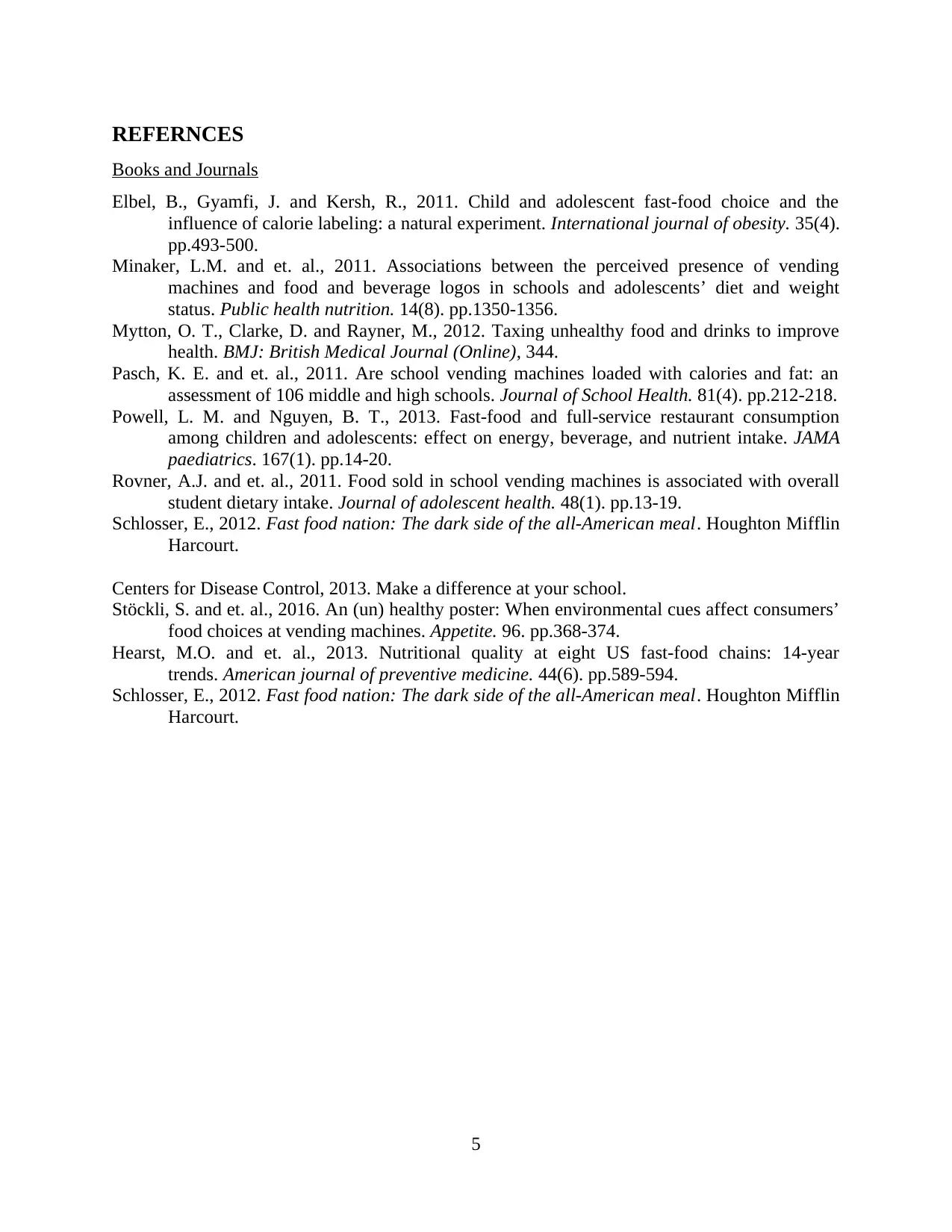
REFERNCES
Books and Journals
Elbel, B., Gyamfi, J. and Kersh, R., 2011. Child and adolescent fast-food choice and the
influence of calorie labeling: a natural experiment. International journal of obesity. 35(4).
pp.493-500.
Minaker, L.M. and et. al., 2011. Associations between the perceived presence of vending
machines and food and beverage logos in schools and adolescents’ diet and weight
status. Public health nutrition. 14(8). pp.1350-1356.
Mytton, O. T., Clarke, D. and Rayner, M., 2012. Taxing unhealthy food and drinks to improve
health. BMJ: British Medical Journal (Online), 344.
Pasch, K. E. and et. al., 2011. Are school vending machines loaded with calories and fat: an
assessment of 106 middle and high schools. Journal of School Health. 81(4). pp.212-218.
Powell, L. M. and Nguyen, B. T., 2013. Fast-food and full-service restaurant consumption
among children and adolescents: effect on energy, beverage, and nutrient intake. JAMA
paediatrics. 167(1). pp.14-20.
Rovner, A.J. and et. al., 2011. Food sold in school vending machines is associated with overall
student dietary intake. Journal of adolescent health. 48(1). pp.13-19.
Schlosser, E., 2012. Fast food nation: The dark side of the all-American meal. Houghton Mifflin
Harcourt.
Centers for Disease Control, 2013. Make a difference at your school.
Stöckli, S. and et. al., 2016. An (un) healthy poster: When environmental cues affect consumers’
food choices at vending machines. Appetite. 96. pp.368-374.
Hearst, M.O. and et. al., 2013. Nutritional quality at eight US fast-food chains: 14-year
trends. American journal of preventive medicine. 44(6). pp.589-594.
Schlosser, E., 2012. Fast food nation: The dark side of the all-American meal. Houghton Mifflin
Harcourt.
5
Books and Journals
Elbel, B., Gyamfi, J. and Kersh, R., 2011. Child and adolescent fast-food choice and the
influence of calorie labeling: a natural experiment. International journal of obesity. 35(4).
pp.493-500.
Minaker, L.M. and et. al., 2011. Associations between the perceived presence of vending
machines and food and beverage logos in schools and adolescents’ diet and weight
status. Public health nutrition. 14(8). pp.1350-1356.
Mytton, O. T., Clarke, D. and Rayner, M., 2012. Taxing unhealthy food and drinks to improve
health. BMJ: British Medical Journal (Online), 344.
Pasch, K. E. and et. al., 2011. Are school vending machines loaded with calories and fat: an
assessment of 106 middle and high schools. Journal of School Health. 81(4). pp.212-218.
Powell, L. M. and Nguyen, B. T., 2013. Fast-food and full-service restaurant consumption
among children and adolescents: effect on energy, beverage, and nutrient intake. JAMA
paediatrics. 167(1). pp.14-20.
Rovner, A.J. and et. al., 2011. Food sold in school vending machines is associated with overall
student dietary intake. Journal of adolescent health. 48(1). pp.13-19.
Schlosser, E., 2012. Fast food nation: The dark side of the all-American meal. Houghton Mifflin
Harcourt.
Centers for Disease Control, 2013. Make a difference at your school.
Stöckli, S. and et. al., 2016. An (un) healthy poster: When environmental cues affect consumers’
food choices at vending machines. Appetite. 96. pp.368-374.
Hearst, M.O. and et. al., 2013. Nutritional quality at eight US fast-food chains: 14-year
trends. American journal of preventive medicine. 44(6). pp.589-594.
Schlosser, E., 2012. Fast food nation: The dark side of the all-American meal. Houghton Mifflin
Harcourt.
5
1 out of 7
Related Documents
Your All-in-One AI-Powered Toolkit for Academic Success.
+13062052269
info@desklib.com
Available 24*7 on WhatsApp / Email
![[object Object]](/_next/static/media/star-bottom.7253800d.svg)
Unlock your academic potential
Copyright © 2020–2025 A2Z Services. All Rights Reserved. Developed and managed by ZUCOL.





